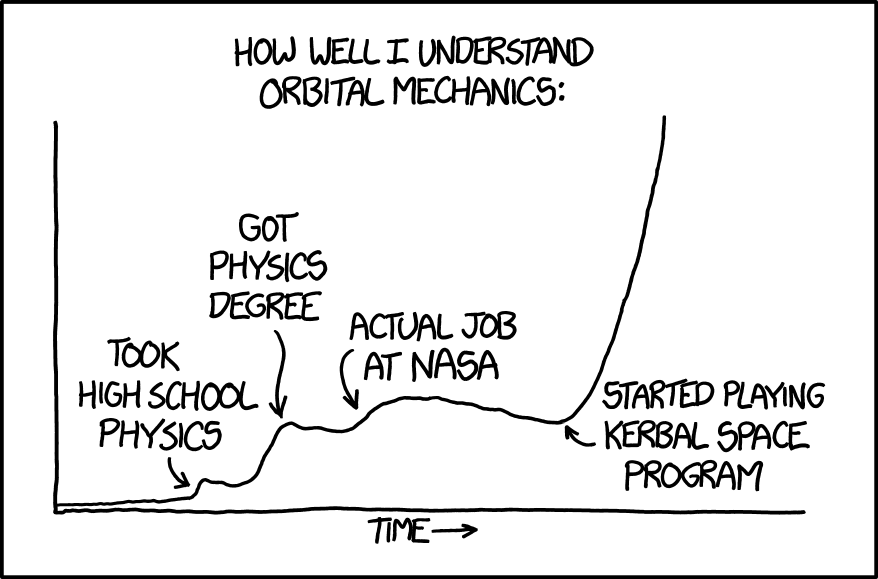Instructions unclear. I’m going to the moon on Delta IX.
You could always put them in a co-orbit with earth or something and then just use solar sails to provide the delta-v
But I also like the idea of certain peeps having time to understand the error of their ways before slowly falling into the sun faster and faster.
And before some one says “well, there’s still plenty of time for that with a rocket…”
Naw. We’re talking about a truly idiotic person. It’s gonna take them a while,
Launch them into Betelgeuse instead. It’s a bigger target anyway.
If we’re going for a bigger target, let’s go all out and aim for Stephenson 2-18. Go big or go home!
Sagittarius A* would like a word, and you’ll never get that word back.
I see your Sagittarius A* and raise you one TON 618.
So you’re telling me shooting a space gun at the sun will miss?
No, just that you’ll need to use a longer casing on your round.

Yeah, but propelling them out of the solar system just sounds like the kind of fake-ending that ends up with the super villain coming back stronger in a decade. Have we learnt nothing from science fiction? You have to destroy your foes whilst you can.

The phantom zone ain’t gonna cut it.
Which angel is that?
It blows my mind that this was cutting edge, jaw dropping graphics back in the day. A shape-shifting trapezoid with some panicked faces peeking out.
E. Nah now I’m thinking it’s a one dimensional parallelegram.
What blows my mind is that I could right now recreate this in moments on a cheap, low-power microcontroller.
That shit’s laughable, but then there was Superman III and the trauma it caused:

That scene scared the shit out of me
Yes, one is a final solution, the other is just pushing your problems elsewhere without regard for who else it could affect.
From the https://tvtropes.org/pmwiki/pmwiki.php/Main/EvilOverlordList
4: Shooting is not too good for my enemies.
7: When I’ve captured my adversary and he says, “Look, before you kill me, will you at least tell me what this is all about?” I’ll say, “No.” and shoot him. No, on second thought I’ll shoot him then say “No.”
13: All slain enemies will be cremated, or at least have several rounds of ammunition emptied into them, not Left for Dead at the bottom of the cliff. The announcement of their deaths, as well as any accompanying celebration, will be deferred until after the aforementioned disposal.
Man, I haven’t thought of the Evil Overlord List in many, many years. Thanks for that.
They can still come back from another parallel reality or some such - villains are like cats, they always come back (unless they are bored and then they don’t).
Sun’s bad then too. Don’t want them Voyage Homeing their way into the past
Back when RT wasn’t shit.
Imploding submarines are far more efficient
Okay when the options are throwing a football down field or up field, the option to hit a softball with a sledgehammer isn’t helpful.
Going easy on traitors is how Germany gave us WWII.
But we gave him a nice little prison stay to write his manifesto in! Surely he learned his lesson and won’t attempt to overthrow democracy again, right?
…right?
To the depths of Jupiter, then.
Well, I guess this applies to me. I say that a lot.
Ummm… quick question: Isn’t that all just a matter of timing?
The only way to be sure is to try both ways in Kerbal Space Program.
Lol, is there a version for macOS?
(Please don’t don’t downvote me, I need to use Photoshop for work)
Looks like it runs on Mac.
(Better repent and switch to Gimp on Arch /J)
Why is that - wouldn’t you be working against solar gravity? Like you don’t have to get them there quickly, just launch them in some orbit that will decay and be taken in?
It’s an easy talking point from the Internet and high school text books, it is disregarding of many actualities of our universe. It would be true if the sun were an infinitely small point on a 2 dimensional plane with a perfect lack of friction.
And while for instantaneous results it would be easier to get something out of the sun’s gravity well rather than hit the exact middle of the sun, practically, if you have time, and you don’t actually need it to hit dead center of the sun, it’s much cheaper and easier to incinerate something proximal to the sun than it is too send it out of the solar system.
Also let’s not forget gravity sling shots work in both directions.
You’re starting with the speed of the earth
Y’all need to pay some Kerbal Space Program. It’ll teach you more about orbital mechanics than a physics degree and a job at NASA (according to XKCD). The only problem is, once you have this knowledge, a lot of sci fi becomes annoying.

Because the Earth is really cookin’, and
anythinganyone you hurl toward the sun will inherit that orbital velocity as well, meaning that they’ll actually end up going around the sun, instead of into it. And due to the speed it would pick up on its way in, it would basically take up a highly-eccentric yet stable elliptical orbit.“Well, what if we throw them in the other direction, to make up for it?” That’s called retrograde, and that’s basically exactly what you’d have to do: cancel out the Earth’s entire orbital velocity. Which would take a lot of energy, plus a couple of really exacting gravity assists from planets on the way in.
(Edit to add: I may have explained this poorly. Basically, if you don’t change your orbital speed at all, any movement you make toward or away from the host body means you just end up in an orbit of the same average distance, but in a more eccentric [elliptical] shape.)
By contrast, even though the escape velocity from the solar system is no slouch (42 km/s), you get to start with the Earth’s orbital velocity (30 km/s)–meaning you’re already a little under 3/4 of the way there. Plus, if you can make it to Jupiter and Saturn, you can get a significant gravity assist, and they’re much bigger targets for such a maneuver than Mercury or Venus are.
So, yeah, bottom line: you only need a delta-V of about 12 km/s to get out of the solar system, but a delta-V of 30 km/s to get to the sun without going into orbit.
That’s a great explanation, thanks! 🙏
That’s assuming all cows are a point on a frictionless 2 dimensional plane.
-
you don’t need to hit the sun dead center to be incinerated.
-
the sun is huge
-
you aren’t in a frictionless environment, your orbit will decay into the sun.
These are all technically correct but fairly inconsequential. Even just to graze the sun you need to lose 90% of your orbital velocity. And although everything orbiting the sun will eventually fall in, the friction is really low. It will take billions of years to lose enough velocity to fall in.
Billions of years and billions of times less energy, would you agree?
If you’re willing to settle for that kind of timeline, you could “launch someone into the sun” by just…leaving them on Earth for five billion years. At that point, the sun will become a red giant and probably expand to engulf the Earth.
What does engulfing the earth mean to you? The mass of the sun expanded to a body 1 au would not be very dense. My money says the earth would continue to orbit “inside the sun” for quite a while, but the orbit would degrade more quickly.
But yes, I argue get them out of the earths gravity well and let Newton handle the rest, no reason to propel them in any direction, eventually they’ll get to the sun.
If the sun became a red giant tomorrow, and Earth found itself inside the outer layers of solar atmosphere, then drag would start slowing it down. In less than 70,000 years, it would fall close enough to the center to be torn apart by tidal forces like one of Saturn’s moons (assuming it hasn’t already been vaporized).
If we’ve already waited 5 billion years to have our revenge, whats another 70k? The lowest amount of Delta V we can spend on this project is zero.
No that’s not really the case, the earth will be destroyed.
-
So, yeah, bottom line: you only need a delta-V of about 12 km/s to get out of the solar system, but a delta-V of 30 km/s to get to the sun without going into orbit.
This is true, but the possibility of gravity assists mostly nullifies the difference. If you can get out to Jupiter you can basically choose: either let it sling you out of the system, or let it cancel out all your orbital velocity so you fall into the sun.
I feel like that might be difficult to do without just falling into Jupiter, but I am no rocket scientist.
You can just change the shape of your orbit (but not your orbital energy) with the help of a sufficient gravity well from solar orbit, so it intersects with the Sun. Drag (aerobraking!) within the Sun will slow whatever is left of you enough to sap your orbital energy
Why would you need to entirely cancel the earths orbital velocity, surely you just need to cancel a tiny bit of orbital velocity?
Edit: https://space.stackexchange.com/questions/43913/do-you-need-0-km-s-velocity-to-crash-into-the-sun
Canceling out only a tiny bit puts you on an orbit similar to earth’s. You need to kill basically all of your momentum.
Good question, but if you cancel out only a little bit of orbital velocity, you just orbit in a little bit closer. Without any appreciable drag acting on you, there’s nothing that will keep your orbit decaying. You’ll just be in a smaller, perhaps slightly more eccentric orbit.
But you’d need a higher velocity to orbit closer…
Yeah, orbital mechanics gets a little bit mind-bendy sometimes. If you’re in a stable circular orbit, accelerating in the direction you’re traveling will actually result in you traveling more slowly because you have moved to a higher orbit, and firing engines to slow down will actually speed you up because you move in closer to the host body and take up a faster orbit.
This is actually a problem spacecraft deal with regularly. If a Dragon capsule is behind the ISS and wants to dock, using its thrusters to accelerate toward the ISS will actually result in it falling further behind. Decelerating will get it closer, though it will then be in a lower orbit. Orbital rendezvous is tough.
Why would an orbit decay without something to slow the spacecraft down like an atmosphere? The problem is that any object we launch from earth has a lot of orbital velocity, which makes it almost impossible to hit the sun directly, you would have to use a lot of complex gravity assists from the inner planets to take away enough momentum. Using gravity assists to accelerate outwards is much easier
Why do you need to hit the exact center of the sun to have the desired results? Get it within the orbit of Mercury and I’ll be happy enough.
That’s what the premise of this post was. It’s a common saying to “shoot something into the sun”, which sounds easy at first but is actually quite hard to do. That’s the joke
My argument is it’s more energy efficient to shoot something towards the sun that will have the same result as hitting the sun than it is to get it out of the solar system.
It’s just not true though, unless you do an out then in maneuver.
the issue is not counteracting gravity, the issue is decelerating enough to hit the sun
I remember watching a video about that. The gist is that you have to leave earth orbit or something idk.
You leave earth orbit into a solar orbit that is slightly shifted depending on which direction you were facing when you left earth’s orbit
To escape a body of mass you need to have enogh velocity (kinetic energy) to overcome the gravitational pull of that body. You can imagine it like a ball sitting in a bowl. With little velocity it will just roll back and forth but if it’s fast enough it can roll out of the bowl and escape it’s influence.
That critical speed is called “escape velocity” and it depends on mass and distance from a body. The escape velocity of earth (from the surface) is about 11.2 km/s and the sun’s escape velocity (from earth orbit) is about 42.1 km/s. Earth orbits around the sun at about 29.8 km/s. If you launch in the direction of Earth’s orbit, you will orbit the sun already at about 41 km/s, so you “only” need 1.1 km/s more to escape the sun, too.
If you tried to reach the sun, you could launch in the opposite direction leaving you orbiting the sun at about 18.6 km/s. Since there is almost nothing in space you won’t slow down from friction and the orbit won’t decay. Instead you’d have to accelerate opposite the direction you’re traveling. Now, calculating exactly how much you’d need to decelerate isn’t trivial since you don’t want a stable orbit but an elliptical orbit that just touches the sun at the closest point (perihel). I don’t know how much deceleration that takes, but it’s propable that it’s easier than accelerating by 1.1 km/s to escape the sun.
That’s the thing - in space, orbits don’t decay. Orbital decay only happens if there’s dust or atmosphere that you bump into along your orbit to slow you down. But in interplanetary space, there’s no dust or atmosphere, and certainly not enough to decay your orbit fast enough to achieve results (otherwise, the Earth would have already decayed and melted in the Sun)
You need to spend fuel to lower your orbit to hit the Sun, and you need to spend fuel to raise your orbit to escape the solar system. It turns out to be really freaking difficult to hit the sun because it simply requires so much fuel to lower your orbit enough to hit the Sun.
You are making 2 opposing assumptions there, 1) there is nothing to bump into in outer space, the earth picks up 43 tons of new mass every day.
- the earths orbit would decay, the earth is absolutely massive compared to the amount of mass gained, and also off gasses a significant amount of mass every day.
If orbits don’t decay, why do even high orbit satellites need to make elevation corrections?
If you put a small body into outer space it would absolutely be (slowly) effected by the miasma of particles out there.
And let’s not forget we don’t have a time table for reaching the sun, and we aren’t aiming for the middle of the sun to see results. And as you approach the sun you will bump into more and more particles as they too are being drawn around the sun.
Sir Isaac Newton is the deadliest son of a bitch in space
how much to put them into a space suit and a car, strap them to a rocket and then fire them into orbit around Mars ?
If the idea is to be rid of the person completely, we don’t need to fire them into the sun. Or launch them out of the solar system. They don’t even need to reach earth escape velocity.
Just launch them at the sun. Use whatever method you like. Just get them high enough that after gravity starts to overpower acceleration, there is no chance for survival. Boom! No more person. For the most part.
You’d still be moving some 30km/s around the sun, and need to decelerate from that speed.
Does the velocity of the earth around the sun enter into it if the projectile doesn’t come anywhere close to leaving earth’s gravitational pull? When I said “at the sun” it was just a direction. A gesture towards the spirit of the original “into the sun.” They won’t reach it. They’ll just be a splat mark [insert parabola math here]-ish meters away.
A bit of a woosh. He’s saying you only need to throw someone off a building or out of a plane and they’ll die falling to the ground. No need to leave Earth.
New slogan: Launch all billionaires straight up into the air using one of those circus cannons
Just launch lots of tiny bits of processed earth at them super fast. More propellant efficient and you don’t have to worry that they might have packed a parachute.
Wouldn’t shooting them into Jupiter be the easiest?
I’m sure I’ve read a few things about what an impact that big bugger has on trajectories in our solar system.
Intuitively I feel like a push towards Jupiter would be easier than a push to get all the way out of the solar system avoiding Jupiter.
Exceptions do apply, things like near-immortal beings or cursed objects may require the destructive power of a Sun and no less
Even with the explanations given here, it’s still very counter-intuitive for me.
I think the best thing would be to cut the person in half, send one half towards the sun and the other half out of the solar system.
The issue is that you’re starting from earth, and the earth already has a lot of momentum that keeps it from falling into the sun. To get an object from here to the sun you would need to counter the majority of that momentum it already has.
It’s not about the propellant, it’s about sending a message
Huh. I would have thought that once they break orbit that the sun’s gravity well would do the heavy
liftingpulling.The vessel would still have a lot of speed after escaping earth’s orbit, so the trajectory would become a large orbit around the sun. You still have to slow down by about ~30km/s (or ~100 000 km/h) to make that orbit intercept with the sun’s surface.
If you care to learn orbital mechanics, Kerbal Space Program is a great teacher.
That one’s been sitting unplayed in my library for a very long time. I guess it’s time to give it a shot.
And if you want more complicated orbital mechanics there’s a ksp mod: Principia which adds n-body orbital mechanics over ksp’s relatively simple patched conic orbital simulation.
once you break out of earth orbit you are now in an orbit around rhe sun, similar to earths.
“Breaking orbit” still leaves you in almost the same orbit around the sun as the earth. You need to slow down a lot to bring the periapsis of the orbit within the suns surface.
Imagine that you’re standing on a train and have a baseball. If you throw the ball off the train, the ball will still have momentum in the direction of the train’s movement.
If you want to throw the ball to a friend the train just passed, you have to be able to throw the ball faster than the train is moving or it will never reach them.
Now all im imagineing is a ball floating mid air and it’s beautiful
Mythbusters did this! (Well, the ball fell to the ground, but for a split second it looked like it was hovering after being shot out of a cannon.)

















